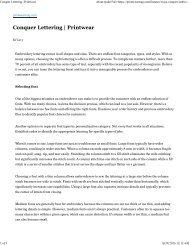Embroidery Basics Articles
Create successful ePaper yourself
Turn your PDF publications into a flip-book with our unique Google optimized e-Paper software.
10/28/2016 Understanding Alphabet and Font Options<br />
each method and how you can use each to your advantage.<br />
1. CustomDigitized Lettering<br />
When creating logos, I prefer this method because there are small nuances to<br />
most lettering that only are captured by digitizing from the artwork, and in this<br />
method, the lettering is digitized specifically for each job.<br />
The other reason to custom digitize lettering is to make it run ef ficiently. Custom<br />
lettering created by a professional or experienced digitizer is production friendly ,<br />
and has the proper underlay and density values for the fabric onto which it will be<br />
stitched. I don’t try to force a keyboard font into a logo unless it’ s a perfect match.<br />
Using a keyboard font for a logo rarely results in the same highquality sewout that<br />
can be achieved when the lettering is custom digitized.<br />
Sometimes special considerations — like time and money — can get in the way of<br />
using customdigitized lettering. In these instances, three choices remain: keyboard<br />
fonts, autodigitized T rueType fonts and alphabets as designs.<br />
Shop Spotlight<br />
2. Digitized Keyboard Fonts<br />
This quickandeasy method is how most of us embroiderers create lettering for<br />
everyday jobs, from personalized sewouts to poems and scriptures, and everything<br />
in between.<br />
In this method, letters and words are typed at the computer keyboard in much the<br />
same way as you type in a word processing program like Microsoft W ord. The user<br />
selects the style, size, density and other parameters, and the stitches are<br />
generated according to the user ’s instructions.<br />
In most systems, the resulting lettering is fully editable. The best practice is to save<br />
in the native format of the software so that it can be edited later , in the event that it<br />
doesn’t stitch as planned or you discover a misspelling. Then, save the lettering to<br />
a stitch file, such as DST or EXP, to be easily read by an embroidery machine.<br />
Even though the software you regularly use probably has about 100 digitized<br />
keyboard fonts, chances are good that you use only a few select favorites. That’ s<br />
because you know them well and they’re reliable. You don’t have to do a test<br />
sewout before each job because you have used these fonts so many times that you<br />
can predict the styles that will work well in a small size, as well as the ones that are<br />
bold enough to stand out on plush material.<br />
Process Engineering<br />
When Michael Rothermund got laid of f from his<br />
fourth job in the engineering industry , he knew it<br />
was time for a change — and all signs pointed to<br />
the Tshirt business...<br />
Read more<br />
A L P H A B E T<br />
T E M P L A T E F R E E<br />
easytemplatemanager.com<br />
Customize & Print Templates<br />
Quickly Search 100s of Free<br />
Templates Now!<br />
Of course, you know the “bad” fonts too — such as the script fonts that have<br />
awkward connections or strange characters (like a “T” that looks like an “I” and an<br />
“S” that doesn’t look like any handwriting you’ve ever seen). Some sophisticated<br />
software packages allow you to edit characters and save them for future use.<br />
Still, I’m a believer that you can hardly have too many lettering software packages.<br />
When trying to match a keyboard font to a specific customerrequested font style, it<br />
seems that the customer ’s lettering always has at least one character that’ s<br />
different than the similar font in your system. Instead of spending up to an hour<br />
trying to edit the character , a different software package could have a font that<br />
more closely matches what your customer wants. Most embroidery software brands<br />
have reasonably priced lettering packages, which are good for ensuring lots of<br />
lettering options.<br />
3. TrueType Font Generation<br />
Modern software packages also usually include a T rueType font generator that<br />
converts TrueType fonts into stitches. This can be useful for certain lettering styles<br />
and sizes, but the resulting lettering sometimes contains incorrect stitch directions<br />
and other edits may be needed.<br />
When used with discretion and proper settings, this type of lettering can serve a<br />
purpose. However, be aware that many TrueType fonts will need to be adjusted to<br />
their column widths using the “Pull Compensation” feature of your software.<br />
http://impressions.issshows.com/embroiderydigitizing/UnderstandingAlphab7162.shtml 2/4




